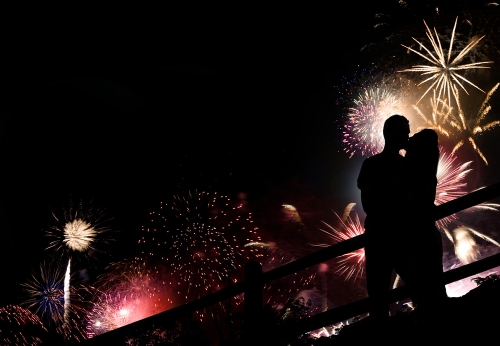Holidays are often distinguished by the traditions that are observed. Every holiday has traditions that come from a rich historical background. Find out more about the fun traditions for major holidays below!

Christmas
Christmas is a holiday steeped in traditions, both cultural and familial. Some of the most fun traditions for Christmas are:
- Candy Canes – These peppermint sticks are one of the definitive flavors of the Christmas season. A popular myth surrounding candy canes is that they originated in 1670 when a German choirmaster gave “J” shaped white sugar sticks to children so they would remain quiet during Christmas services. As cute as the story is, it’s widely regarded as a mere myth and the first reference to “candy canes” occurred some 200 years later. The red stripes and peppermint started sometime around the 1900s.
- Mistletoe – Getting caught under the mistletoe can be a great experience, or it can be super awkward. The use of mistletoe dates back to the ancient Druids who used the parasite (yes, this plant is a parasite that attaches itself to a host) to ward off evil spirits and bring good luck to a home. The tradition of kissing under the mistletoe dates back to Norse mythology, where it was used as a symbol of friendship and love. The next time you step under the mistletoe and don’t want to give a kiss, share the history of the tradition instead.
- The Christmas Pickle – If you haven’t heard of this tradition, you aren’t alone. The Christmas pickle is one of the more bizarre modern Christmas traditions, though your kids are sure to love it. Many share the story that the pickle originated in Germany where the parents would hang a pickle ornament as the very last ornament on the tree and the child who found the ornament would receive an additional present. Oddly enough, most Germans haven’t heard of the story and there are two other wild stories about where the Christmas pickle started one involving St. Nicholas and the other an American Civil War fighter. Wherever the Christmas pickle originated, who doesn’t love an extra present?

New Year’s Eve
New Year’s Eve is one of the biggest party nights of the year with plenty of Champagne flowing and confetti being thrown. Fun New Year’s Eve traditions include:
- The Midnight Kiss – A source of stress for singles and a great excuse for public PDA for couples (or a New Year’s date) the New Year’s kiss dates all the way back to ancient Rome. The Romans are famous for their liberal sexual attitude and the kiss on New Year’s Eve at the Festival of Saturnalia was just the beginning of the evening. Europeans used to (and some still do) hold masquerade balls on New Year’s Eve where the mask symbolizes evil spirits from the previous year. At midnight, the masks are removed and a kiss is shared in an act of purification for the year to come.
- Champagne – New Year’s doesn’t seem complete without a bottle of bubbly. Technically, most people will drink sparkling wine on New Year’s, because you can only call a sparkling wine Champagne when it has been produced in the Champagne region of France. The tradition of toasting to the New Year with some bubbles isn’t actually from a New Year’s celebration specifically. In the 17th century, monk Dom Perignon perfected the wine bottling process because up until his work, bubbles in wine would cause bottles to explode. It was Perignon who created extra thick bottles and added the cage at the top of the bottle, which keeps the cork from popping off. Whether you’re drinking Champagne, sparkling wine, prosecco or cava, enjoy your midnight glass of bubbly.

Easter
Pastels and candy dominate American Easter celebrations and each year the Easter Bunny visits kids and leaves baskets full of goodies.
The Easter Bunny – Kids look forward to the arrival of the Easter Bunny who brings gifts and treats on Easter morning. The exact origins of the Easter Bunny are unknown, but some believe it was born out of the pagan festival of Eostre, the goddess of fertility because rabbits were often used to symbolize fertility. Many believed that the Easter Bunny came to America with German immigrants that settled in Pennsylvania in the 1700s. Initially, the Easter Bunny only delivered eggs but as the popularity grew, the gifts the Easter Bunny left became more extravagant. The giving of chocolate on Easter most likely began in France and Germany during the 19th century. Traditionally, children were told to create hats or nests in which the Easter Bunny would leave chocolate eggs.

The Fourth of July
Sparklers, fireworks and a deep appreciation for the red, white and blue are what make this American holiday so unique. Traditions for the Fourth of July include:
- Fireworks – The culmination of Fourth of July celebrations ends with impressive firework displays, but why? Surprisingly, the tradition of setting off fireworks is as old as the country, with a display of fireworks on July 4, 1977 that was meant to raise morale and spirits. In fact, pretty much all of the traditions we observe from picnics to parades, are in some way a reflection of the first Fourth of July, though the events are definitely grown in grandeur.
Labor Day
Labor Day, celebrated on the first Monday of September, was first celebrated in New York City on Tuesday, September 5, 1882. It was not until 1884 that the first Monday of the month was adopted as the designated holiday. One of the major traditions for Labor Day, other than shopping, is a parade. In a proposal outlining what the celebration and observance of Labor Day, it is written that parades are to be held to showcase the strength and spirit of laborers and labor unions. While there are still parades, they are becoming less common and most Americans celebrate with a barbecue to signal the end of the summer.

Halloween
Halloween is one of the most fun of the year and some of the most fun traditions observed at Halloween include:
Dressing up in Costumes – One of the most fun things about Halloween is deciding what you’re going to dress up as! The earliest reference to dressing up at Halloween come out of Scotland in 1585, although many believe the tradition of costumes may have started earlier. The Celtic countries of Scotland, Ireland, Mann and Wales are all heavily referenced in the 18th and 19th centuries in accordance with the Celtic festivals of Samhain and Calan Gaeaf. Originally, costumes were meant to be frightening and were based in folklore. It was around the1930s that costumes based on popular culture became the norm.
- Trick-or-Treating – The American tradition of trick-or-treating comes from the German Belsnickling which was derived from the German-American communities that engaged in Peltznickel. During Peltznickel, children would call on their neighbors to see if the adults could guess their identities. It wasn’t until 1927 that the term “trick-or-treating” appeared. Sugar rationing in during World War II caused trick-or-treating to surge in the 1950s, and it has continued to remain the most popular kid’s activity on Halloween night.

Thanksgiving
A day full of food, family and friends, Thanksgiving is rooted deep in tradition, but it may surprise you how some of these fun traditions originated.
- The Turkey – Turkey on Thanksgiving is a given. It is so popular in fact that some people refer to Thanksgiving as Turkey Day, but it wasn’t the pilgrims that started this tradition. Pilgrims were more likely to feast on venison than turkey, so why is turkey the superstar of Thanksgiving? One of the reasons we eat turkey is practical: because chicken and cows eggs and milk respectively, and turkey is raised and hunted solely for meat. Sarah Joseph Hale, who was editor of Godey’s Lady Book used her influence to make Thanksgiving a national holiday and she wrote recipes for turkey and pumpkin pie in Godey’s Lady Book, passing these on to the masses. This also explains why pumpkin pie is one of the most celebrated traditions on Thanksgiving.
Football – The tradition of football games on Thanksgiving Day started when the first football game was played on the holiday in Philadelphia, Pennsylvania in 1869. In 1882, the Intercollegiate Football Association decided to hold an annual championship on Thanksgiving Day in New York City. The tradition of football on Thanksgiving applies to virtually all levels; high school, college, amateur and professional.
Now that you know more about the fun holiday traditions you enjoy, you can pass the knowledge onto friends and family and have a deeper appreciation for why it is you do what you do on these festive occasions.
